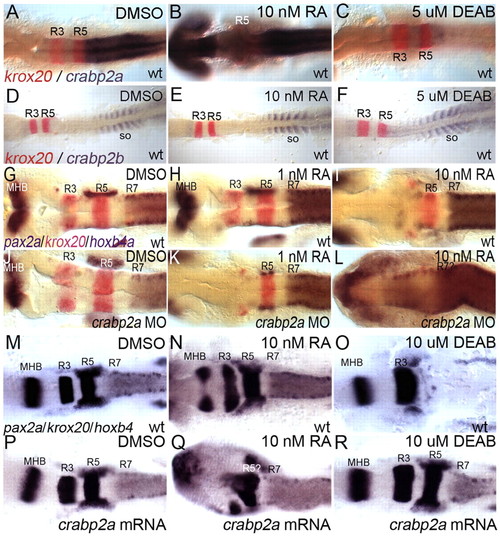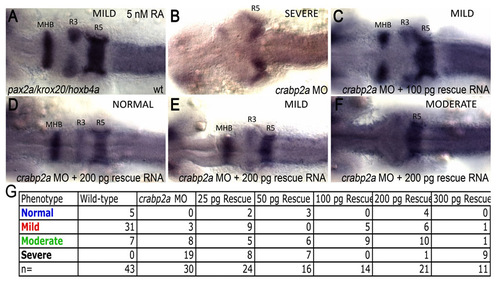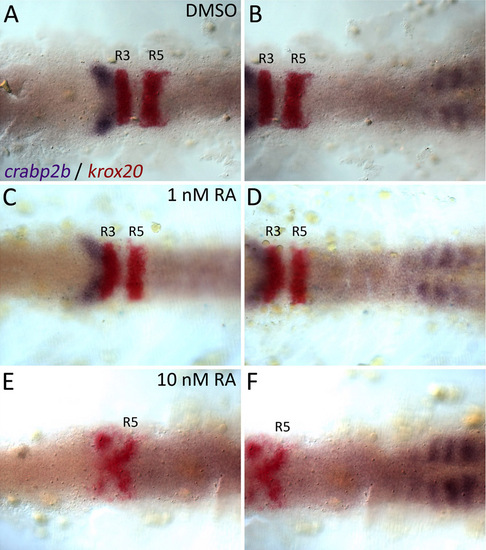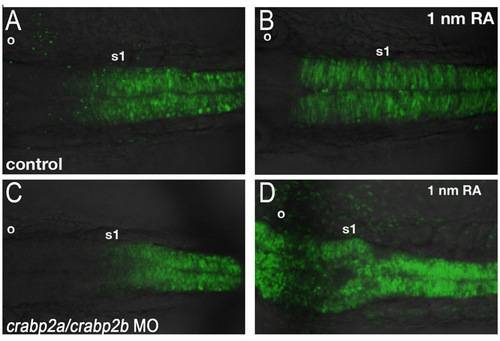- Title
-
Cellular retinoic acid-binding proteins are essential for hindbrain patterning and signal robustness in zebrafish
- Authors
- Cai, A.Q., Radtke, K., Linville, A., Lander, A.D., Nie, Q., and Schilling, T.F.
- Source
- Full text @ Development
|
crabp2a and crabp2b are required for zebrafish hindbrain patterning. (A-L) Whole-mount in situ hybridization (ISH) for pax2a at the midbrain-hindbrain boundary (MHB), krox20 in rhombomere (R) 3 and R5, and hoxb4 (A-H) or hoxb5 (I-L) in R7 and spinal cord at 18 hpf; dorsal views, anterior left. Compared with uninjected controls (A), morpholino (MO) depletion of Crabp2a (B,J) or Crabp2b (C,K) slightly reduces and co-injection (D,L) eliminates hoxb4 and hoxb5 expression (arrows). Exogenous RA treatments (5-20 nM) that posteriorize the hindbrain do not rescue hoxb4 expression (E-H). wt, wild type. EXPRESSION / LABELING:
PHENOTYPE:
|
|
crabp2a is RA inducible and required for signal robustness. (A-F) Whole-mount ISH for crabp2a/b expression at 15 hpf; dorsal views, anterior left. crabp2a (A-C) is expressed posterior to the R5/6 boundary, whereas crabp2b (D-F) expression is restricted to somites. Treatment with 10 nM RA expands crabp2a expression anteriorly throughout the CNS (B) but has no effect on crabp2b (E). Treatment with 5 μM DEAB eliminates crabp2a expression (C) but does not disrupt crabp2b (F). (G-R) pax2a, krox20 and hoxb4 expression at 18 hpf in uninjected controls (G-I), Crabp2a-MO-injected (J-L) and crabp2a mRNA-injected embryos (M-R) treated with 1 nM RA (H,K), 10 nM RA (I,L,N,Q) or 10 μM DEAB (O,R). so, somites. EXPRESSION / LABELING:
PHENOTYPE:
|
|
Expression patterns of crabp2a and crabp2b. (A-L) Whole-mount in situ hybridizations for crabp2a (A-F) and crabp2b (G-L), lateral views, anterior to the left, of embryos between 8.5 (A,G) and 24 (F,L) hpf. crabp2a is first detected in the posterior hindbrain and anterior spinal cord at 10 hpf (B), and expression expands anteriorly and posteriorly from 12-24 hpf (C-F). crabp2b is broadly expressed during gastrulation (G), becomes excluded from the anterior head by 10 hpf (I), and later is largely restricted to R2 at 12 hpf (J) and to newly formed somites and the tail by 15 hpf (K,L). (M,N) Flat-mounted embryos, dorsal views, co-labeled for krox20 (red) and crabp2a (M) or crabp2b (N) at 12 hpf. E, eye; HB, hindbrain; R3-5, rhombomeres 3-5; SC, spinal cord; SO, somites. EXPRESSION / LABELING:
|
|
Temporal expression of all four zebrafish Crabps. (A-D) RT-PCR amplification from cDNA isolated from whole embryos at various hours postfertilization using primers specific for each Crabp. EXPRESSION / LABELING:
|
|
crabp2a and crabp2b morpholinos specifically block translation of co-injected mCherry-tagged mRNA constructs. (A-C) mCherry fluorescence in gastrula stage embryos injected at the one-cell stage with 200 pg crabp2a:mCherry mRNA alone (A; 100%, n=28), co-injected with Crabp2a-MO1 (B; 100%, n=16) or Crabp2a-MO2 (C; 94%, n=18). (D-F) Corresponding DIC images. (G-I) Fluorescence in embryos injected with 200 pg crabp2b:mCherry mRNA alone (G; 100%, n=21), together with Crabp2b-MO1 (H; 86%, n=14), or Crabp2b-MO2 (I; 94%, n=16). (J-L) Corresponding DIC images. |
|
crabp2a knockdown phenotypes can be partially rescued by crabp2a mRNA. (A-F) Whole-mount in situ hybridization for pax2a, krox20 and hoxb4; dorsal views, anterior to the left. Embryos co-injected with Crabp2a-MO and either 100 pg (C) or 200 pg crabp2a rescue mRNA (D-F) and treated with 5 nM RA showed an improvement in krox20 expression compared with Crabp2a-MO-injected embryos treated with 5 nM RA (B), but rescue is not complete compared with wild-type embryos treated with 5 nM RA (A). (G) Proportions of embryos with each phenotype. Results are also summarized in Fig. 4C. |
|
Hindbrain-specific crabp2b expression is not RA inducible. crabp2b expression in the anterior hindbrain (A) is not induced by 1 nM RA treatments (C); however, expression is lost with 10 nM RA treatments (E), most likely owing to the posteriorization of the hindbrain as evidenced by the disorganized krox20 expression and lack of change in expression of crabp2b in the somites (B,D,F) under all treatment conditions. |
|
Increased RARE:YFP expression in response to exogenous RA after crabp2a and crabp2b knockdown. Live Tg(RARE-gata2:NTD-eYFP)Id1 transgenics, dorsal views of the hindbrain, anterior to the left. (A,B) Expression extends just anterior to the level of somite 1 (s1) in DMSO-treated controls (A) and extends further anteriorly <100 μm after treatment during gastrulation with 1 nM exogenous RA (B). (C,D) crabp2a/crabp2b knockdown alone slightly reduces Tg(RARE-gata2:NTD-eYFP)Id1 expression (C), but when combined with 1 nm RA expression expands throughout the CNS (D). ′o′ indicates approximate location of the otic vesicle. EXPRESSION / LABELING:
PHENOTYPE:
|








